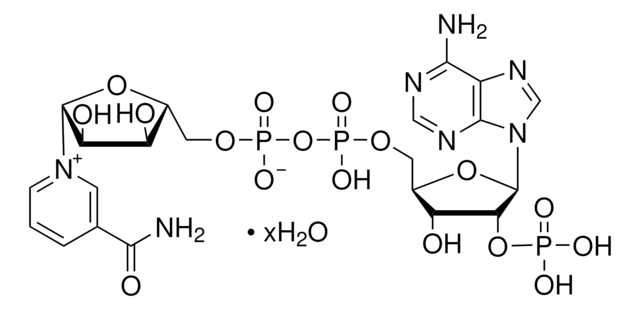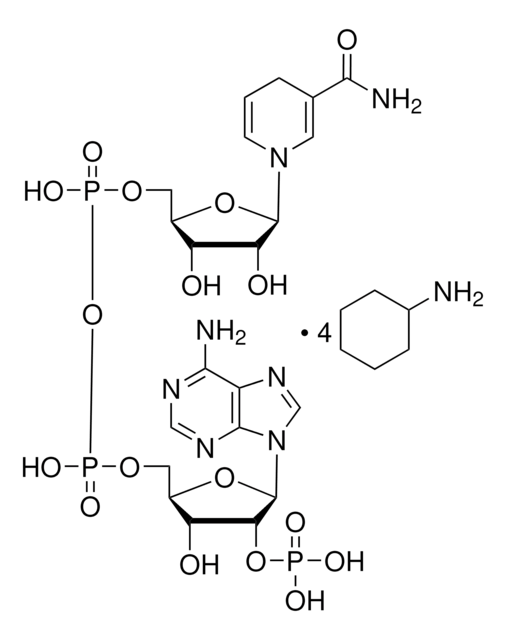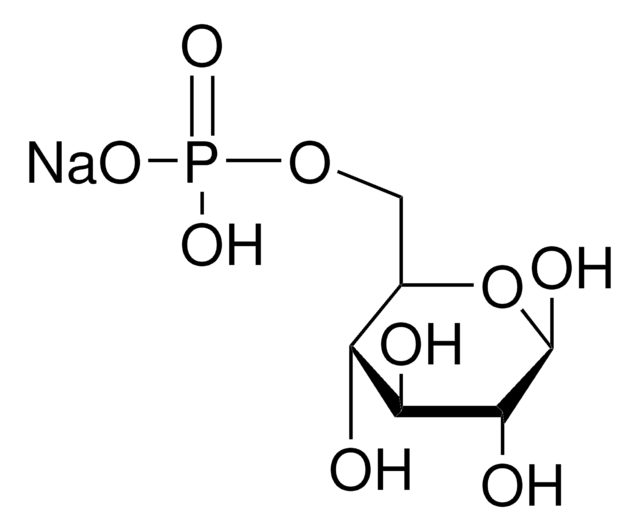F0628
Ferredoxin-NADP+ Reductase from Spinacia oleracea (spinach)
lyophilized powder, ≥15 units/mg solid, secondary activity: ≥10 units/mg solid NADPH diaphorase
Synonyme(s) :
Ferridoxin-NADP+ oxidoreductase
Se connecterpour consulter vos tarifs contractuels et ceux de votre entreprise/organisme
About This Item
Numéro CAS:
Numéro MDL:
Code UNSPSC :
12352204
Nomenclature NACRES :
NA.54
Produits recommandés
Forme
lyophilized powder
Niveau de qualité
Activité spécifique
≥15 units/mg solid
Activité étrangère
NADH diaphorase activity ≤10 units/mg solid
Température de stockage
−20°C
Description générale
Ferredoxin-NADP+ Reductase is a ferredoxin-soluble partner with a molar ratio to PSI of 0.9 and 3.
Application
Ferredoxin-NADP+ Reductase from Spinacia oleracea (spinach) has been used to test the effect of potential protein partners on the activity of the glyceraldehyde-3-phosphate dehydrogenase (GAPDH)−CP12 preparation. It has also been used in standard assay conditions for phycocyanobilin:ferredoxin oxidoreductase (PcyA) enzyme assay.
Ferredoxin-NADP+ Reductase was used in in vitro ferredoxin-dependent desaturation of fatty acids in cyanobacterial thylakoid membranes. It was also used to regulate glyceraldehyde-3-phosphate dehydrogenase.
Actions biochimiques/physiologiques
Ferredoxin-NADP+ reductase catalyzes the reversible conversion of reduced ferredoxin to oxidized ferredoxin during photosynthesis. Ferredoxin-NADP(H) reductase constitutes a family of hydrophilic FAD-containing monomeric enzymes that deliver NADPH or low potential one-electron donors to redox-based metabolisms in plastids, mitochondria, and bacteria.
Ferredoxin-NADP+ reductase catalyzes the reversible conversion of reduced ferredoxin to oxidized ferredoxin during photosynthesis. Ferredoxin-NADP(H) reductase constitutes a family of hydrophilic FAD-containing monomeric enzymes that deliver NADPH or low potential one-electron donors to redox-based metabolisms in plastids, mitochondria, and bacteria.
Définition de l'unité
One unit will reduce 1.0 millimole of cytochrome C per min at pH 7.5 at 25 °C in the presence of spinach ferredoxin and NADP.
Code de la classe de stockage
11 - Combustible Solids
Classe de danger pour l'eau (WGK)
WGK 3
Point d'éclair (°F)
Not applicable
Point d'éclair (°C)
Not applicable
Équipement de protection individuelle
Eyeshields, Gloves, type N95 (US)
Certificats d'analyse (COA)
Recherchez un Certificats d'analyse (COA) en saisissant le numéro de lot du produit. Les numéros de lot figurent sur l'étiquette du produit après les mots "Lot" ou "Batch".
Déjà en possession de ce produit ?
Retrouvez la documentation relative aux produits que vous avez récemment achetés dans la Bibliothèque de documents.
Les clients ont également consulté
A Conserved Histidine-Aspartate Pair Is Required for Exovinyl Reduction of Biliverdin by a Cyanobacterial Phycocyanobilin:Ferredoxin Oxidoreductase
Tu SL, et al.
The Journal of Biological Chemistry, 281(6), 3127-3136 (2006)
Néstor Carrillo et al.
European journal of biochemistry, 270(9), 1900-1915 (2003-04-24)
Ferredoxin (flavodoxin)-NADP(H) reductases (FNR) are ubiquitous flavoenzymes that deliver NADPH or low potential one-electron donors (ferredoxin, flavodoxin) to redox-based metabolisms in plastids, mitochondria and bacteria. The plant-type reductase is also the basic prototype for one of the major families of
Glyceraldehyde-3-phosphate dehydrogenase is regulated by ferredoxin-NADP reductase in the diatom Asterionella formosa
Mekhalfi M, et al.
The New phytologist, 203, 414-423 (2014)
Ferredoxin-NADP+ Reductase KINETICS OF ELECTRON TRANSFER, TRANSIENT INTERMEDIATES, AND CATALYTIC ACTIVITIES STUDIED BY FLASH-ABSORPTION SPECTROSCOPY WITH ISOLATED PHOTOSYSTEM I AND FERREDOXIN
Cassan N, et al.
The Journal of Biological Chemistry, 280(28), 25960-25972 (2005)
Min Seok Cho et al.
Journal of microbiology (Seoul, Korea), 50(3), 496-501 (2012-07-04)
The Gram-positive bacterium Clavibacter michiganensis subsp. michiganensis is the causal agent of canker disease in tomato. Because it is very important to control newly introduced inoculum sources from commercial materials, the specific detection of this pathogen in seeds and seedlings
Notre équipe de scientifiques dispose d'une expérience dans tous les secteurs de la recherche, notamment en sciences de la vie, science des matériaux, synthèse chimique, chromatographie, analyse et dans de nombreux autres domaines..
Contacter notre Service technique












